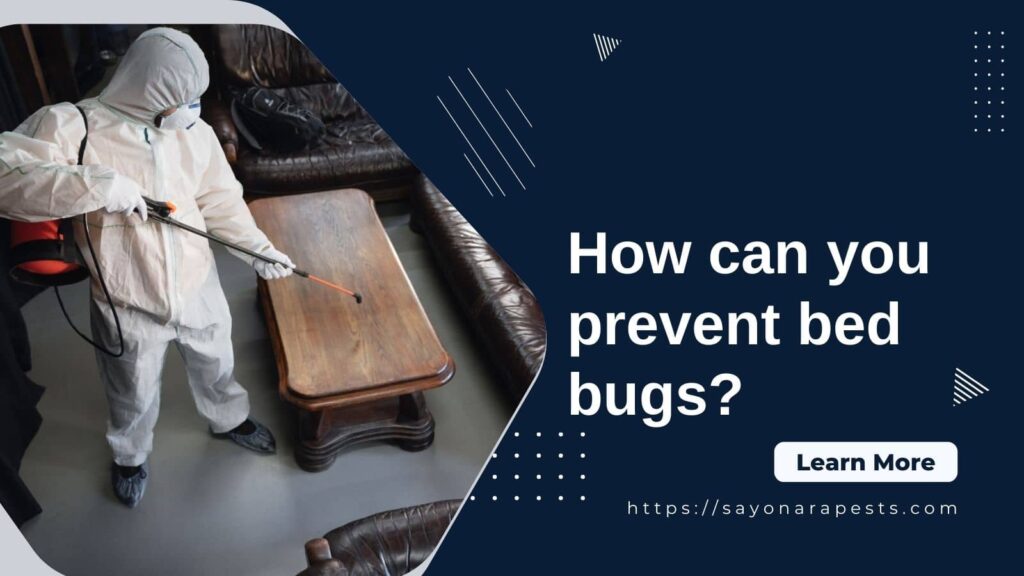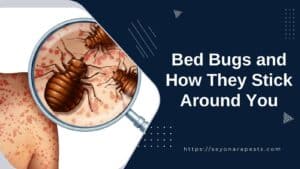It is very important to keep bed bugs out of your bed for many reasons. Bed bugs are parasites that feed on human blood. They can cause skin irritation, allergic reactions, and trouble sleeping, among other things.
Also, bed bug infestations can spread quickly through a home, making it hard and expensive to get rid of them. By taking good preventive steps, you can protect yourself and your family from the physical pain and emotional stress that bed bug bites can cause.
You can also save money by not having to pay to get rid of bed bugs and replace infested bedding and furniture.
In this detailed guide, we’ll look at ten important ways to keep bed bugs out of your bed. Each tip covers a different part of prevention, so you’ll have a multi-layered plan for keeping your sleeping space safe.
These tips cover things like cleaning and maintenance, using protective cases, getting rid of clutter, sealing cracks, taking precautions when traveling, doing your laundry right, taking care of your pets, using bed bug interceptors and traps, educating yourself and others, and knowing when to call a professional pest control service.
If you follow these tips carefully, you can make your bed much less likely to have bed bugs and make it a safe and peaceful place to sleep.
Tip 1: Regularly Clean and Vacuum Your Bedding
In order to get rid of bed bugs, you need to clean your bedding often. Bed bugs are known for being able to hide and have babies in the tiniest spaces, like your sheets, mattress, and pillows.
By cleaning your bedding often, you get rid of their hiding places and any bugs or eggs that might be there. This keeps bed bugs from getting out of hand and keeps them out of your bed.
There are different ways to clean different types of bedding, and it’s important to use the right method to get rid of bed bugs. Sheets, pillowcases, and blankets that can be washed must be washed in hot water.
Bed bugs don’t like heat, so to kill them, you should wash at a temperature of at least 120°F (49°C). Using a high-quality detergent or an insecticide-laced laundry additive made just for bed bugs can also make the cleaning process more effective.
When it comes to mattresses, box springs, and pillows that can’t be washed, vacuuming is the best way to clean them. Start by loosening any bed bugs or eggs that are stuck to the surface with a stiff brush or a stiff-bristle attachment on your vacuum cleaner.
Then, vacuum all sides of the mattress well, paying special attention to seams, edges, and tufts. To keep the pests from coming back, empty the vacuum bag or canister into a sealed plastic bag and throw it away right away.
Vacuuming is a powerful way to get rid of bed bugs, but you have to do it the right way for it to work. Use a vacuum with a strong suction and a high-efficiency particulate air (HEPA) filter to pick up even the smallest dust particles when you clean your bedding.
Start by vacuuming the mattress, paying special attention to the seams, tufts, cracks, and crevices where bed bugs might hide. Move the vacuum slowly to give the suction enough time to pull the bugs and their eggs into the vacuum.
After you’ve finished vacuuming the mattress, move on to the box spring, bed frame, and headboard. Bed bugs often hide in these places, so they should be thoroughly vacuumed. Look at the seams, screw holes, and any other small places where bed bugs could hide.
Make sure to clean the vacuum cleaner after each use so that bed bugs don’t get out. Empty the contents into a sealed bag, wash or replace the vacuum filter, and wipe down the outside of the vacuum to make sure no bugs or eggs are left behind.
By cleaning and vacuuming your bedding regularly using the right methods and techniques, you can greatly reduce the chances of getting bed bugs and make your bed a healthier place to sleep. It’s an important step to take to keep bed bugs away and get a good night’s sleep.
Tip 2: Use Protective Bedding Encasements
Bed bug-proof encasements are specially-made covers that wrap all the way around mattresses, box springs, and pillows to keep bed bugs out. These covers are made of fabrics that are tightly woven and have pores that are too small for bed bugs to get through.
The zippers on these encasements are also made to keep bed bugs out. This makes sure that the bugs can’t get out of or into the bedding that is encased.
One of the most important things about bed bug-proof encasements is that they can completely seal off the mattress, box spring, or pillow, leaving no gaps or openings for bed bugs to hide or breed.
This keeps bed bugs from getting to the places they like to hide and limits their movement, making them easier to find and get rid of. Bed bug-proof encasements are also made to last and not tear easily, so they can protect against bed bug infestations for a long time.
Using protective bedding encasements can help fight bed bugs in a number of ways. First of all, encasements keep bed bugs from getting into your mattress, box spring, or pillows in the first place.
Encasements prevent bed bugs from getting to their favorite hiding places by making an impenetrable barrier. This lowers the risk of an infestation.
Also, encasements that keep bed bugs out make it easier to find and get rid of bed bugs. Since the encasements completely seal the bedding, any bed bugs that are there won’t be able to get out.
This makes it easier to spot signs of a bed bug problem, like feces stains or skins that have fallen off, and take action right away to solve the problem.
Encasements also make treatments for bed bugs more effective and efficient. If there are bed bugs on the mattress, box spring, or pillows, it can be hard to get rid of them all.
But when encasements are used, bed bugs are kept inside the encased bedding, which makes it easier to treat them with targeted methods like steam cleaning or insecticide spraying.
Encasements also act as a barrier that keeps bed bugs from getting back into the bedding after it has been treated.
For the best protection, you should think about a few things when choosing bedbug-proof covers for your mattress, box spring, or pillows.
First, choose encasements that say “bed bug proof” or “bed bug encasements” on the label. These products are made to resist bed bug infestations and have been put through a lot of testing to make sure they work.
Second, pay close attention to the fabric and how the encasements are made. Look for encasements that are made of tightly woven fabrics with pores that are 6 microns or smaller.
This makes it impossible for bed bugs to get through. The fabric should also be strong and hard to tear so that it can stand up to regular use and possible contact with sharp things.
Next, think about how the encasements are closed. Choose encasements with high-quality zippers that bed bugs can’t get through and that can completely seal off the bedding.
Bed bugs shouldn’t be able to get in or out, so the zippers should have small teeth and a way to lock them.
Lastly, make sure the covers are the right size for your mattress, box spring, and pillows. The cases should fit tightly and securely, with no gaps or loose spots that bed bugs can use.
Carefully measure your bedding and look at the product details to choose the right size.
By choosing bed bug-proof encasements that meet these requirements, you can protect your bedding from bed bug infestations and create a barrier that will help you sleep better and give you peace of mind.
Tip 3: Maintain Clutter-Free Bedrooms
Bed bugs can easily hide in a cluttered bedroom, which makes it easier for them to spread and make more of themselves. Bed bugs are pests that come out at night and like to hide in dark, quiet places during the day.
Clutter, like piles of clothes, stacks of books, or too much furniture, gives bed bugs many places to hide where they can live without being seen.
These pests are great at hitchhiking, and they can easily climb onto things in crowded places, which makes the chance of an infestation higher. Clutter also makes it harder to find bed bug infestations and treat them quickly, since the bugs can easily hide in the mess.
To reduce the chance of getting bed bugs, it’s important to keep your bedroom clean and free of clutter. Here are some tips that will help you get rid of clutter:
Make a plan first: Make a plan for getting rid of the clutter in your bedroom by breaking it up into smaller tasks. Focus on places like closets, under the bed, and nightstands that tend to get cluttered.
Sort and put things into groups: Sort through your things and put them into groups like “keep,” “donate,” and “throw away.” Don’t be afraid to get rid of things you don’t need or use to make your home less cluttered.
Invest in bins, baskets, shelves, or other storage solutions to keep things organized and off the floor. Choose containers that can be sealed to keep bed bugs from getting to the things you’re storing.
Regular maintenance: Set up a routine to keep your bedroom neat. Make it a habit to put things back where they belong, and don’t let things pile up over time.
It’s important to check and clean storage areas on a regular basis to prevent bed bug infestations and catch early signs of their presence. Why is it so important?
Early Detection: Bed bugs like to hide and have babies in places like closets and storage rooms. By checking these places often, you are more likely to find bed bugs or their signs, like shed skins, feces stains, or eggs, before the infestation gets worse.
Targeted treatment: If you find bed bug signs in your storage areas, you can act quickly to get rid of the problem. By putting away the infested items and cleaning or throwing them away properly, you can stop the bugs from moving to other parts of your house.
Prevent reinfestation: If storage areas aren’t cleaned well, they can be a place where bugs can come back. By cleaning these areas on a regular basis, you get rid of any possible hiding places or signs of bed bug activity, making it less likely that they will come back.
When cleaning storage areas, vacuum thoroughly and pay attention to cracks, corners, and crevices where bed bugs may hide. For better reach, you might want to use a vacuum attachment with a narrow nozzle.
Also, use a damp cloth or a mild cleaning solution to wipe down shelves and surfaces. Make sure to follow the directions on any cleaning products you use, and don’t use harsh chemicals that could hurt the things you’re storing.
By keeping your bedroom clean and free of clutter, putting your things in order, and regularly checking and cleaning your storage areas, you can make it much less likely that bed bugs will get into your bed and home.
Taking these precautions will help make sure you can sleep peacefully and without bed bugs.
Tip 4: Seal Cracks and Crevices in Your Bedroom
Bed bugs are known for being able to get into tiny cracks and crevices, so it’s important to find and seal off places where they could get in. These hardy pests can get into your home in many different ways.
Bed bugs often get in through cracks in walls, baseboards, electrical outlets, and even joints in furniture. Also, bed bugs can come into your home on infested furniture, luggage, or clothing.
By knowing where they are getting in, you can take specific steps to keep them out and protect your bed.
Sealing up cracks and crevices in your bedroom is a good way to keep bed bugs from coming in.
Start by carefully checking your bedroom, paying close attention to places where bed bugs might hide, like along the baseboards, behind picture frames, and in the seams of your furniture. Once identified, employ suitable techniques to seal these entry points.
Use a high-quality sealant, like silicone caulk, to fill in cracks in walls and baseboards. Use a lot of sealants and make sure the seal is tight to stop bed bugs from getting in. Pay close attention to the corners, edges, and any openings that you can see.
Also, think about putting in door sweeps and weatherstripping to stop bed bugs from getting in through the cracks under doors.
When looking at furniture, check the seams, joints, and any gaps you can see. Depending on the type of furniture, you may be able to seal off any holes with wood putty, adhesive caulk, or upholstery tape.
Make sure that any holes or cracks in wood furniture are filled and sealed well. Use a hot glue gun or upholstery tape to seal off any possible hiding places in upholstered furniture.
It’s best to get help from a professional if you have a serious bed bug problem or if you’re not sure if you can effectively seal off entry points. Pest control professionals have the knowledge, experience, and tools they need to find bed bugs’ hidden entry points and get rid of them effectively.
When you hire professional, trained technicians will check your bedroom and the area around it carefully to find all possible entry points. Then, they will use advanced techniques and treatments to get rid of the problem.
These may include chemical treatments, heat treatments, or a combination of both, depending on your situation. Professionals can also give you advice on how to keep bed bugs out of your bedroom in the long term and how to prevent them from coming back.
Remember that it can be hard to handle a serious infestation on your own, and hiring a professional can save you time, effort, and maybe even some frustration.
Their experience makes sure that they take a complete approach that gets to the root of the problem and helps you get back in charge of your bedroom.
By sealing cracks and crevices in your bedroom and getting help from a professional when necessary, you can make it much less likely that bed bugs will get into your bed.
These preventive steps not only keep bed bugs away from your sleeping space but also give you peace of mind because you know you’ve done what you can to keep them away.
Tip 5: Be Cautious When Travelling
One of the most common ways bed bugs can get into your home when you travel is through your luggage and other things you bring back with you. Bed bugs are known to hitchhike, and they can easily attach themselves to clothing, bags, or other things without being seen.
They can spread to hotel rooms, planes, trains, and even public transportation. Once you bring these infested items home, bed bugs can quickly spread to your bed and other places, leading to a full-blown infestation.
For prevention, it’s important to know how bed bugs can get into a place while traveling.
Taking precautions before and during your trip can make it much less likely that you’ll bring bed bugs back home with you. Before you leave, check your luggage and other personal items to make sure they don’t have any signs of bed bugs.
Look for small brown or reddish stains, bug skins that have fallen off, or even live bugs. If any signs are found, the problem must be fixed before going on a trip so that the infestation doesn’t spread.
Use hard-shell suitcases or bags with zippers that close tightly on your trip. Compared to soft fabric luggage, these are less likely to have bed bugs in them. Also, putting dirty clothes in plastic bags and clean clothes in plastic bags can help keep germs from spreading.
If you don’t want bed bugs to get into your luggage, keep your things off the floor and off the ground in hotels and other places you stay.
When you check into a hotel or other temporary place to stay, you need to check the room carefully to make sure there are no bed bugs.
Start by putting your bags in the bathroom or on a luggage rack where they won’t get in the way of the bed or other furniture. Bed bugs are most likely to be in and around the bedroom, so that’s where you should focus your inspection.
Carefully look for signs of bed bugs, such as dark spots or live bugs, in the seams, headboards, and bed frames.
Use a flashlight to light up the area and look for cracks, crevices, and folds where bed bugs could be hiding. Check the room’s upholstered furniture, curtains, and carpets, as well.
If you want to make sure there aren’t any bed bugs in your luggage, check it outside or on a hard surface before you leave the hotel. Make sure there are no bed bugs in your bags by checking the seams, pockets, and folds.
If you think there are bed bugs or see signs of them, you should tell the hotel management right away and think about changing rooms or staying somewhere else.
By being careful and taking these steps, you can make it much less likely that you’ll bring bed bugs home with you from your trip. The best way to avoid bed bugs during and after your trip is to stay alert.
Tip 6: Launder and Dry Your Clothes Properly
The most important thing you can do to keep bed bugs from getting into your clothes is to wash them the right way. Start by sorting your clothes and putting away anything you think might have bugs.
This will make it less likely that bed bugs will spread to other pieces of clothing. Also, think about putting infested items in a sealed plastic bag to keep bed bugs and their eggs from spreading.
To get rid of bed bugs from your clothes, you must follow certain steps when washing and drying them. First, choose wash cycles with hot water because bed bugs can’t handle high temperatures.
Set the temperature of the water to at least 120°F (49°C) to make sure it works well. Next, use a laundry detergent that kills bed bugs and is known to be good at it.
After washing the clothes, make sure they are completely dry. Bed bugs hate the heat, so set the dryer to the highest heat setting that won’t hurt your clothes.
Run the dryer for at least 30 minutes to kill all bed bugs, bed bug eggs, and bed bug nymphs. Check the care labels on your clothes to make sure they can be dried at a high temperature.
To stop bed bugs from spreading, you need to be careful with infested clothes and bedding. If you can, don’t move infested items around your house.
This could lead to more infestations. Instead, put the clothes that have bugs in them straight from the sealed plastic bag into the washer. This will keep the bugs from spreading to other surfaces.
After washing and drying the infested items, you might want to store them in plastic bags or containers with tight-fitting lids to keep the bugs from coming back. This will make a barrier between the clothes you just cleaned and any bed bugs that are still around.
Don’t put clothes that have bugs on them back in drawers or closets without taking the right precautions.
It’s important to know that if you have a severe infestation, you may need help from a professional to get rid of bed bugs from your clothes and bedding.
Pest control experts have access to treatments like heat treatments and chemical solutions that can be very effective at getting rid of bed bugs from fabrics.
By washing and drying your clothes the right way and being careful when handling infested clothes, you can greatly reduce the chance that bed bugs will get into your closet and spread to other parts of your home.
Bed bugs can be hard to get rid of, but if you stay alert and check your clothes and bedding often, you can catch any possible infestations early and take quick, effective steps to get rid of them.
Tip 7: Regularly Inspect and Treat Your Pets
Accidentally, pets like dogs and cats can bring bed bugs home with them. Bed bugs like to feed on human blood, but they can also bite animals and feed on their blood.
When a pet walks through a bed bug-infested area, the bugs can jump on their fur or feathers and move to other parts of the house.
Because of this, it is important to know how pets spread bed bugs and take the steps needed to stop infestations.
Pets need to be part of the inspection and treatment process if you want to get rid of bed bugs. Here are some ways to check for and treat bed bugs on your pets:
Look at your pets often to see if they show any signs of bed bug activity. Look for small reddish-brown stains on their fur or tiny bite marks on their skin. The stains could be bed bug poop.
Grooming and combing: Use a fine-toothed comb to groom your pets often. This can help find bed bugs or eggs that may be stuck in the animal’s fur. During grooming, if you see any signs of bed bugs, you should act right away.
Bathing and cleaning: Give your pets regular baths with warm water and shampoos that are safe for animals. Bed bugs don’t like water and may drown when you take a bath. Also, regularly washing your pet’s bedding and toys in hot water can kill any bed bugs that might be there.
Consult a vet: If you think your pet has been bitten by bed bugs or is having skin problems, you should talk to a vet. They can check out your pet and give it the right treatment to make it feel better.
Keeping your pet clean is important not only for their overall health but also to keep bed bugs from coming into your home. Why is pet hygiene so important?
Infestations can be avoided by making sure your pets are clean and well-groomed. This makes it less likely that they will pick up bed bugs and bring them into your home.
Bed bugs are less likely to hitch a ride on your furry friend if you give them regular baths, groom them, and clean their things.
Early detection: If you check on your pets regularly, you can spot any signs of bed bugs early on. When you find an infestation quickly, you can act quickly to stop it from spreading to other parts of your home.
Comprehensive pest control: If you have a bed bug problem, it’s important to get rid of all possible sources, like pets. You can make sure that your pest control plan is more thorough and effective if you include your pets in the inspection and treatment process.
Remember that bed bugs can be a big problem and make both you and your pets feel bad. By knowing how pets can spread bed bugs, using the right inspection and treatment methods, and making sure your pets are clean, you can reduce the risk of bed bug infestations and make your home healthier for everyone.
Tip 8: Use Bed Bug Interceptors and Traps
Bed bug interceptors and traps are good ways to find bed bugs and keep track of them in your home. These things are made to catch bed bugs as they try to get onto your bed or up the legs of your furniture.
Interceptors are usually put under the legs of your bed, and traps can be placed near places where you think bed bugs might be hiding.
Bed bug interceptors are usually made of plastic or metal. They have a shallow ring on the outside that fits under the leg of a piece of furniture and a reservoir or well on the inside that holds a substance that traps the bugs.
Traps, on the other hand, have sticky surfaces or are filled with a liquid or powder that attracts bed bugs and stops them from moving when they touch it.
Follow these steps to use interceptors and traps for bed bugs well:
Placement: Put an interceptor under each leg of your bed and make sure that the legs fit inside the outer ring. Place traps near the bed, like along the baseboards, in corners, or behind pieces of furniture.
Isolating the bed: Move your bed away from the wall and make sure no bedding touches the floor. This can give bed bugs other ways to get in.
Check the interceptors and traps regularly to see if there are any signs of bed bugs. Look for bugs that are still alive, shed skins, or dark spots that could mean they are there.
Record and watch: Keep a record of where and when you find bed bugs. This will help you figure out how bad the problem is and how to treat it.
When checking the interceptors and traps, if you find bed bugs that have been caught, it is important to know how to handle them so they don’t get away or spread. Here are some guidelines:
Carefully throw away any bed bugs you catch. You can use disposable gloves or tweezers to take bed bugs out of the interceptor or trap. Put them in a plastic bag or container that can be closed.
Seal and throw away: Tightly seal the bag or close the container to keep the bed bugs from getting out. Put the bag or container in a trash can outside or follow the rules that your local waste management authorities have given you.
Clean and sanitize: Once the bed bugs are gone, clean the interceptors or traps as directed by the manufacturer. Clean them to get rid of any bed bug residue and get them ready to use again.
Continue to watch: check and clean the interceptors and traps on a regular basis and replace them as needed. Monitoring the activity of bed bugs will help you figure out how well your preventative measures are working and guide your ongoing efforts to get rid of pests.
By using bed bug interceptors and traps as part of your plan to get rid of bed bugs, you can find and keep track of their presence on your own.
This lets you act quickly and treat them more precisely. Make sure to follow the instructions for how to use it and keep a close eye on things to keep the bed bug problem under control.
Tip 9: Educate Yourself and Others
Bed bugs can be stopped from spreading by getting the word out about how to avoid getting them. You can help prevent bed bug infestations by educating yourself and others.
Start by learning the signs of a bed bug problem, such as small reddish-brown stains on bedding or small dark spots on mattresses. By noticing these signs early, you can take action right away and stop the problem from getting worse.
Sharing what you know about bed bugs is one of the best ways to stop them from taking over your home. Tell your friends, family, and neighbors how dangerous bed bugs can be and how important it is to take precautions.
Tell them to check their bedding and living spaces often and to use the other tips in this guide. Stress how important it is to find the problem early and act quickly to stop it from spreading to other people.
There are many resources that give detailed information about bed bugs that you and others can use to learn more. Sites online, like those of reputable pest control companies and government health agencies, have full guides on how to prevent and treat bed bugs.
Most of the time, these resources have step-by-step instructions, videos, and answers to frequently asked questions (FAQs) that can help with specific problems.
Also, think about going to local workshops or seminars put on by professionals in pest control. There, you can learn firsthand how to avoid bed bugs and how to treat them effectively.
By getting the word out, sharing what you know, and using the tools available, you can help yourself and others stop bed bug infestations.
Remember that education is a powerful tool in the fight against bed bugs and that if you take preventative steps, you can help make your home and community free of bed bugs. Stay informed and watch out for bed bugs, and we can keep them away.
Tip 10: Seek Professional Pest Control Services
When it comes to getting rid of bed bugs, there are times when you need the help of a professional pest control service. It is very important to know the signs that you need help from a professional.
If you have tried different ways to keep bed bugs away but they keep coming back, it might be time to call in the experts. Bed bug bites that keep coming back despite your efforts and the presence of bed bugs in more than one room or area of your home are signs that you need professional help.
Also, you should talk to a pest control expert if you can’t find the source of the problem or if it’s causing you a lot of stress and getting in the way of your daily life.
When it comes to getting rid of bed bug infestations, there are many reasons to hire a professional. First of all, professionals have the knowledge, skills, and experience to find and get rid of bed bugs effectively.
They are trained to do thorough inspections, find hidden places where bed bugs live, and come up with different treatment plans based on how bad the infestation is.
Professionals in pest control also have access to specialized equipment and insecticides that are better at getting rid of bed bugs than products you can buy at the store.
By hiring a professional, you can take advantage of their all-around approach that will get rid of bed bugs at every stage of their lifecycle. Pest control experts can also give advice on how to avoid future infestations and keep an eye on things to make sure they don’t come back.
When you hire an exterminator to get rid of bed bugs, it’s important to know what to expect during the process. Usually, the first step is a thorough inspection of your property to find out how bad the problem is and where the bugs are most active.
Based on what they find, the pest control expert will make a personalized treatment plan that may include both chemical and heat treatments or a mix of the two. Bed bugs will be killed at all stages of their lives, including when they are eggs, nymphs, and adults.
During the treatment, you may be asked to leave for a short time to protect your safety and help the pest control experts do their jobs.
It’s important to do what the experts tell you to do to get ready, like washing and bagging clothes, getting rid of clutter, and vacuuming. This preparation helps make sure that the treatment works as well as possible.
After the first treatment, pest control experts may come back to check on the situation and make sure that the infestation is gone for good.
They may also suggest ways to keep bed bugs from coming back. It’s important to remember that the time it takes to get rid of an infestation completely can change depending on how bad it is and what treatments are used.
Bed bug infestations can be dealt with more effectively by hiring a professional pest control service.
You’ll be able to get rid of bed bugs in your home if you know how to tell when you need professional help, what the benefits of hiring experts are, and what to expect during the extermination process.
This will help you make smart decisions and take the steps you need to take. Remember that acting quickly and getting help from a professional will not only help you get rid of bed bugs but will also give you peace of mind and a healthier place to live.
Bed bugs can make sleeping uncomfortable and unhealthy, so it’s important to keep them out of your bed. By using the 10 tips above, you can significantly lower the chances of getting bed bugs and the problems they can cause.
Bed bugs aren’t just annoying; they can also hurt your body, make you sick, and make you feel bad about yourself. Taking steps to keep them from getting in your bed is important for your health and peace of mind.
Bed bug infestations are much less likely if you follow these tips, but you still need to be on the lookout and act quickly if you think or see bed bugs in your bed.
To stop the infestation from spreading and causing more problems, it is important to find and stop it as soon as possible. Always check your bed and the area around it for signs of bed bugs, like bloodstains, dark feces spots, or live bugs.
If you see any signs of bed bugs, you should call a professional pest control service right away so they can look at the situation and give you the right treatment. If you don’t deal with the problem or wait too long, it can get worse and harder to get rid of.
By being proactive and quick to act, you can protect your sleeping space and keep your bed free of bed bugs so you can get a good night’s sleep.











